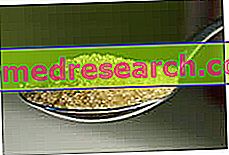The carbohydrates are the sugars and the purpose of their homeostasis (ie balance) is to provide the nervous tissue (brain), in conditions of non-dietary intake, the amount of glucose sufficient for its functioning. The nervous tissue, in fact, to function properly, is strictly glucose-dependent. A further purpose of glucose homeostasis is to store in some organs the excess of energetic substances, in particular glucose, introduced with food, preventing an excessive increase in blood sugar (ie the concentration of glucose in the blood).
After a night of fasting, glucose in the blood is mostly used by the brain, to a lesser extent by red blood cells, intestines and insulin sensitive tissues (muscle and adipose tissue), which is the hormone that it allows these same tissues to take advantage of glucose and store it inside them. The liver is able to store glucose in the form of glycogen (many molecules of glucose "packed" together) and to release it in the form of glucose. The pancreas plays a fundamental role in the homeostasis of sugars. In fact, the production of glucose by the liver is regulated by two hormones, insulin and glucagon. In the absence of insulin there is a release of glucose from the liver into the blood, which leads to an increase in blood sugar ( hyperglycemia ) in the blood itself. In the absence of glucagon, hepatic release of glucose is blocked, with consequent reduction of glucose in the blood ( hypoglycemia ). Furthermore, the use of glucose by other organs, called peripheral, is also reflected in a reduction in blood sugar; this leads to a reduction in insulin levels (amount of insulin circulating), an increase in glucagonemia (amount of circulating glucagon) and a readjustment of the system through an increased hepatic glucose release.

Next to and in equilibrium with the insulin-glucagon system, there is the so-called counter-insular or counterinsular system, represented by the pituitary and adrenal glands. Through the secretion of hormones such as GH, ACTH, cortisol and catecholamines (adrenaline and noradrenaline), this system exerts a hyperglycaemic effect, ie it increases the release of glucose into the circulation.
Following a meal, glucose absorbed from the intestinal tract causes an increase in blood sugar. Carbohydrates (which are polysaccharides, or made up of different types of sugars put together), once reached the intestine, are reduced to monosaccharides, which are glucose (80%), fructose (15%) and galactose (5%). They are then absorbed by the cells of the intestinal mucosa and, from here, are transported to the blood. Generally, after a mixed meal (50% of carbohydrates, 35% of fats, 15% of proteins) the glycaemia returns to pre-preparatory levels (those before lunch) after about 2-3 hours.
The passage and the energy absorption of sugars (but also of proteins and fats) through the alimentary tract, trigger a series of signals that allow the storage of nutrients in various organs. At the same time, the secretion of insulin, the main glycemic regulating hormone, is stimulated. The increase in plasma levels of this hormone causes a decrease in the levels of glucagon, its antagonist, and causes a decrease in hepatic glucose release because it inhibits the breakdown of glycogen into glucose (glycogenolysis) and the synthesis of new glucose by amino acids (gluconeogenesis). The liver, which is freely permeable to glucose, sequesters about 50% of glucose to convert it to glycogen (an action controlled by insulin). Glucose not seized by the liver is distributed in the muscle and adipose tissue. When the blood sugar tends to fall, there is a gradual increase in the hepatic production of glucose, simultaneously with a decrease in plasma insulin levels and an increase in counterinsular hormones, in particular glucagon.



